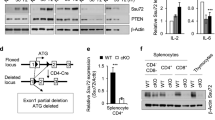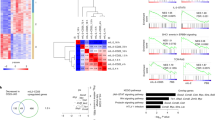Abstract
TRIM28 is a component of heterochromatin complexes whose function in the immune system is unknown. By studying mice with conditional T cell–specific deletion of TRIM28 (CKO mice), we found that TRIM28 was phosphorylated after stimulation via the T cell antigen receptor (TCR) and was involved in the global regulation of CD4+ T cells. The CKO mice had a spontaneous autoimmune phenotype that was due in part to early lymphopenia associated with a defect in the production of interleukin 2 (IL-2) as well as incomplete cell-cycle progression of their T cells. In addition, CKO T cells showed derepression of the cytokine TGF-β3, which resulted in an altered cytokine balance; this caused the accumulation of autoreactive cells of the TH17 subset of helper T cells and of Foxp3+ T cells. Notably, CKO Foxp3+ T cells were unable to prevent the autoimmune phenotype in vivo. Our results show critical roles for TRIM28 in both T cell activation and T cell tolerance.
This is a preview of subscription content, access via your institution
Access options
Subscribe to this journal
Receive 12 print issues and online access
$209.00 per year
only $17.42 per issue
Buy this article
- Purchase on Springer Link
- Instant access to full article PDF
Prices may be subject to local taxes which are calculated during checkout








Similar content being viewed by others
Accession codes
References
Cantrell, D. T cell antigen receptor signal transduction pathways. Annu. Rev. Immunol. 14, 259–274 (1996).
Weaver, C.T., Harrington, L.E., Mangan, P.R., Gavrieli, M. & Murphy, K.M. Th17: an effector CD4 T cell lineage with regulatory T cell ties. Immunity 24, 677–688 (2006).
Jordan, M.S. et al. Thymic selection of CD4+CD25+ regulatory T cells induced by an agonist self-peptide. Nat. Immunol. 2, 301–306 (2001).
Apostolou, I., Sarukhan, A., Klein, L. & von Boehmer, H. Origin of regulatory T cells with known specificity for antigen. Nat. Immunol. 3, 756–763 (2002).
Marks, B.R. et al. Thymic self-reactivity selects natural interleukin 17-producing T cells that can regulate peripheral inflammation. Nat. Immunol. 10, 1125–1132 (2009).
Bettelli, E. et al. Reciprocal developmental pathways for the generation of pathogenic effector TH17 and regulatory T cells. Nature 441, 235–238 (2006).
Mangan, P.R. et al. Transforming growth factor-β induces development of the TH17 lineage. Nature 441, 231–234 (2006).
Veldhoen, M., Hocking, R.J., Atkins, C.J., Locksley, R.M. & Stockinger, B. TGFβ in the context of an inflammatory cytokine milieu supports de novo differentiation of IL-17-producing T cells. Immunity 24, 179–189 (2006).
Zhou, X. et al. Instability of the transcription factor Foxp3 leads to the generation of pathogenic memory T cells in vivo. Nat. Immunol. 10, 1000–1007 (2009).
Tsuji, M. et al. Preferential generation of follicular B helper T cells from Foxp3+ T cells in gut Peyer's patches. Science 323, 1488–1492 (2009).
Lee, Y.K. et al. Late developmental plasticity in the T helper 17 lineage. Immunity 30, 92–107 (2009).
Reymond, A. et al. The tripartite motif family identifies cell compartments. EMBO J. 20, 2140–2151 (2001).
Le Douarin, B. et al. A possible involvement of TIF1α and TIF1β in the epigenetic control of transcription by nuclear receptors. EMBO J. 15, 6701–6715 (1996).
Friedman, J.R. et al. KAP-1, a novel corepressor for the highly conserved KRAB repression domain. Genes Dev. 10, 2067–2078 (1996).
Moosmann, P., Georgiev, O., Le Douarin, B., Bourquin, J.P. & Schaffner, W. Transcriptional repression by RING finger protein TIF1β that interacts with the KRAB repressor domain of KOX1. Nucleic Acids Res. 24, 4859–4867 (1996).
Nielsen, A.L. et al. Interaction with members of the heterochromatin protein 1 (HP1) family and histone deacetylation are differentially involved in transcriptional silencing by members of the TIF1 family. EMBO J. 18, 6385–6395 (1999).
Schultz, D.C., Ayyanathan, K., Negorev, D., Maul, G.G. & Rauscher, F.J. 3rd SETDB1: a novel KAP-1-associated histone H3, lysine 9-specific methyltransferase that contributes to HP1-mediated silencing of euchromatic genes by KRAB zinc-finger proteins. Genes Dev. 16, 919–932 (2002).
Wolf, D. & Goff, S.P. TRIM28 mediates primer binding site-targeted silencing of murine leukemia virus in embryonic cells. Cell 131, 46–57 (2007).
Rowe, H.M. et al. KAP1 controls endogenous retroviruses in embryonic stem cells. Nature 463, 237–240 (2010).
White, D.E. et al. KAP1, a novel substrate for PIKK family members, colocalizes with numerous damage response factors at DNA lesions. Cancer Res. 66, 11594–11599 (2006).
Noon, A.T. et al. 53BP1-dependent robust localized KAP-1 phosphorylation is essential for heterochromatic DNA double-strand break repair. Nat. Cell Biol. 12, 177–184 (2010).
Ziv, Y. et al. Chromatin relaxation in response to DNA double-strand breaks is modulated by a novel ATM- and KAP-1 dependent pathway. Nat. Cell Biol. 8, 870–876 (2006).
Gack, M.U. et al. TRIM25 RING-finger E3 ubiquitin ligase is essential for RIG-I-mediated antiviral activity. Nature 446, 916–920 (2007).
Tsuchida, T. et al. The Ubiquitin Ligase TRIM56 Regulates Innate Immune Responses to Intracellular Double-Stranded DNA. Immunity 33, 765–776 (2010).
Okazaki, I.M. et al. Histone chaperone Spt6 is required for class switch recombination but not somatic hypermutation. Proc. Natl. Acad. Sci. USA 108, 7920–7925 (2011).
Navarro, M.N., Goebel, J., Feijoo-Carnero, C., Morrice, N. & Cantrell, D.A. Phosphoproteomic analysis reveals an intrinsic pathway for the regulation of histone deacetylase 7 that controls the function of cytotoxic T lymphocytes. Nat. Immunol. 12, 352–361 (2011).
Chang, C.W. et al. Phosphorylation at Ser473 regulates heterochromatin protein 1 binding and corepressor function of TIF1β/KAP1. BMC Mol. Biol. 9, 61 (2008).
Stefanová, I., Dorfman, J.R. & Germain, R.N. Self-recognition promotes the foreign antigen sensitivity of naive T lymphocytes. Nature 420, 429–434 (2002).
Cammas, F. et al. Mice lacking the transcriptional corepressor TIF1β are defective in early postimplantation development. Development 127, 2955–2963 (2000).
Takahama, Y. et al. Functional competence of T cells in the absence of glycosylphosphatidylinositol-anchored proteins caused by T cell-specific disruption of the Pig-a gene. Eur. J. Immunol. 28, 2159–2166 (1998).
Linton, P.J., Haynes, L., Tsui, L., Zhang, X. & Swain, S. From naive to effector–alterations with aging. Immunol. Rev. 160, 9–18 (1997).
Veldhoen, M., Hocking, R.J., Flavell, R.A. & Stockinger, B. Signals mediated by transforming growth factor-β initiate autoimmune encephalomyelitis, but chronic inflammation is needed to sustain disease. Nat. Immunol. 7, 1151–1156 (2006).
Nelson, B.H. IL-2, regulatory T cells, and tolerance. J. Immunol. 172, 3983–3988 (2004).
Laurence, A. et al. Interleukin-2 signaling via STAT5 constrains T helper 17 cell generation. Immunity 26, 371–381 (2007).
Zhou, X. et al. Selective miRNA disruption in Treg cells leads to uncontrolled autoimmunity. J. Exp. Med. 205, 1983–1991 (2008).
Graycar, J.L. et al. Human transforming growth factor-β3: recombinant expression, purification, and biological activities in comparison with transforming growth factors-β1 and -β2. Mol. Endocrinol. 3, 1977–1986 (1989).
Webster, K.E. et al. In vivo expansion of Treg cells with IL-2-mAb complexes: induction of resistance to EAE and long-term acceptance of islet allografts without immunosuppression. J. Exp. Med. 206, 751–760 (2009).
King, C., Ilic, A., Koelsch, K. & Sarvetnick, N. Homeostatic expansion of T cells during immune insufficiency generates autoimmunity. Cell 117, 265–277 (2004).
Kench, J.A. et al. Aberrant wound healing and TGF-β production in the autoimmune-prone MRL/+ mouse. Clin. Immunol. 92, 300–310 (1999).
Lowrance, J.H., O'Sullivan, F.X., Caver, T.E., Waegell, W. & Gresham, H.D. Spontaneous elaboration of transforming growth factor β suppresses host defense against bacterial infection in autoimmune MRL/lpr mice. J. Exp. Med. 180, 1693–1703 (1994).
Zhang, Z., Kyttaris, V.C. & Tsokos, G.C. The role of IL-23/IL-17 axis in lupus nephritis. J. Immunol. 183, 3160–3169 (2009).
Caver, T.E., O'Sullivan, F.X., Gold, L.I. & Gresham, H.D. Intracellular demonstration of active TGFβ1 in B cells and plasma cells of autoimmune mice. IgG-bound TGFβ1 suppresses neutrophil function and host defense against Staphylococcus aureus infection. J. Clin. Invest. 98, 2496–2506 (1996).
Münoz-Valle, J.F. et al. The functional class evaluated in rheumatoid arthritis is associated with soluble TGF-β1 serum levels but not with G915C (Arg25Pro) TGF-β1 polymorphism. Rheumatol. Int. 32, 367–372 (2010).
Gutcher, I. et al. Autocrine transforming growth factor-β1 promotes in vivo Th17 cell differentiation. Immunity 34, 396–408 (2011).
Beyer, M. et al. Repression of the genome organizer SATB1 in regulatory T cells is required for suppressive function and inhibition of effector differentiation. Nat. Immunol. 12, 898–907 (1038).
Maloy, K.J. Induction and regulation of inflammatory bowel disease in immunodeficient mice by distinct CD4+ T-cell subsets. Methods Mol. Biol. 380, 327–335 (2007).
Acknowledgements
We thank X. Zhou, A. Shimizu, S. Bailey-Bucktrout, K. Ikuta, T. Eagar, K. Ogasawara and M. Aida for discussions; K. Yurimoto for assistance in mouse genotyping; P. Chambon and R. Losson (Institut de Génétique et de Biologie Moléculaire et Cellulaire, France) for mice with loxP-flanked Trim28 alleles; J. Takeda (Osaka University) for mice with Cre expression driven by the Lck promoter; J. Bluestone (University of California-San Francisco) for Foxp3-GFP-Cre–transgenic mice; S. Nagata (Kyoto University) for CD45.1+ mice; K. Kabashima (Kyoto University) for Rag2−/− mice; and J. Bluestone and N. Minato for critical reading of the manuscript. Supported by the Ministry of Education, Culture, Sports, Science and Technology of Japan (KAKENHI Grant-in-Aid for Scientific Research Young Scientist (B) 21790465 and 23790534 to S.C.) and the Program for the Promotion of Fundamental Studies in Health Sciences of the National Institute of Biomedical Innovation (T.H.).
Author information
Authors and Affiliations
Contributions
S.C. and T.H. designed the research; S.C. did experiments; S.C., N.S. and S.S. did microarrays and analyzed the data; I.-M.O. provided materials essential to the research; and S.C. and T.H. wrote the paper.
Corresponding author
Ethics declarations
Competing interests
N.S. and S.S. are employees of Ono Pharmaceutical.
Supplementary information
Supplementary Text and Figures
Supplementary Figures 1–8 and Table 1 (PDF 1084 kb)
Supplementary Table 2
Microarray comparison of Trim28 regulated genes. (XLS 244 kb)
Rights and permissions
About this article
Cite this article
Chikuma, S., Suita, N., Okazaki, IM. et al. TRIM28 prevents autoinflammatory T cell development in vivo. Nat Immunol 13, 596–603 (2012). https://doi.org/10.1038/ni.2293
Received:
Accepted:
Published:
Issue Date:
DOI: https://doi.org/10.1038/ni.2293
This article is cited by
-
Trim28 citrullination maintains mouse embryonic stem cell pluripotency via regulating Nanog and Klf4 transcription
Science China Life Sciences (2023)
-
TRIM28 SUMOylates and stabilizes NLRP3 to facilitate inflammasome activation
Nature Communications (2021)
-
DNA methylation and hydroxymethylation profiles reveal possible role of highly methylated TLR signaling on Fasciola gigantica excretory/secretory products (FgESPs) modulation of buffalo dendritic cells
Parasites & Vectors (2019)
-
Post-transcriptional regulation of cancer/testis antigen MAGEC2 expression by TRIM28 in tumor cells
BMC Cancer (2018)
-
Epigenetic activation during T helper 17 cell differentiation is mediated by Tripartite motif containing 28
Nature Communications (2018)



